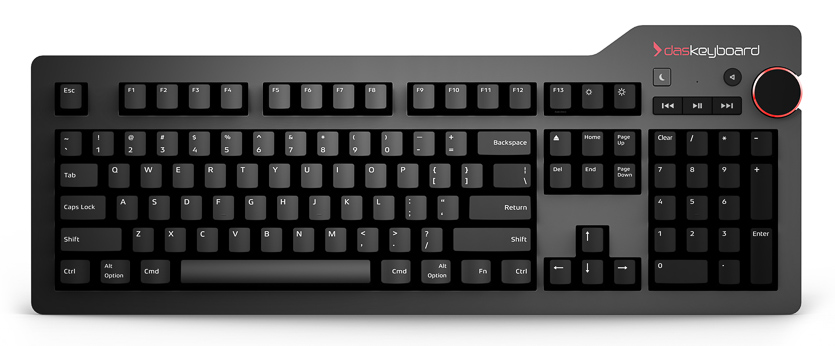High quality mechanical keyboards can last for decades, and Das Keyboard products are no exception. There is one catch: dust and grime will overtake a keyboard long before its switches or electronics begin to fail. Cleaning, the most important keyboard maintenance task, will keep contaminants in check. Spills are another matter entirely, so they’ll get their own section.
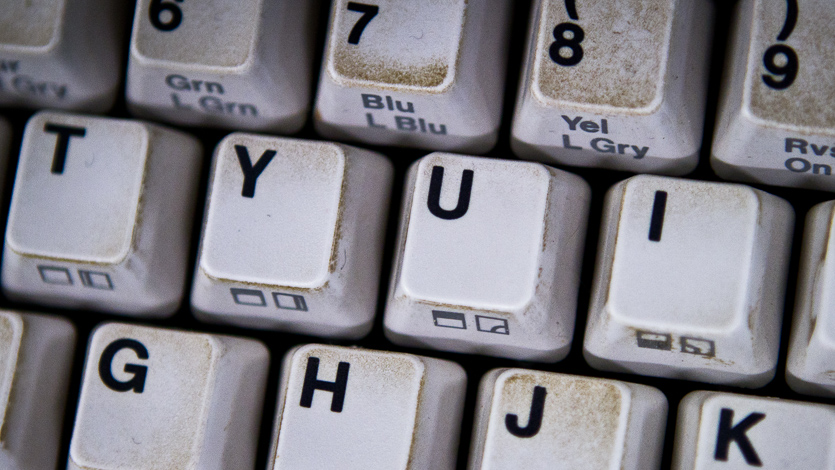
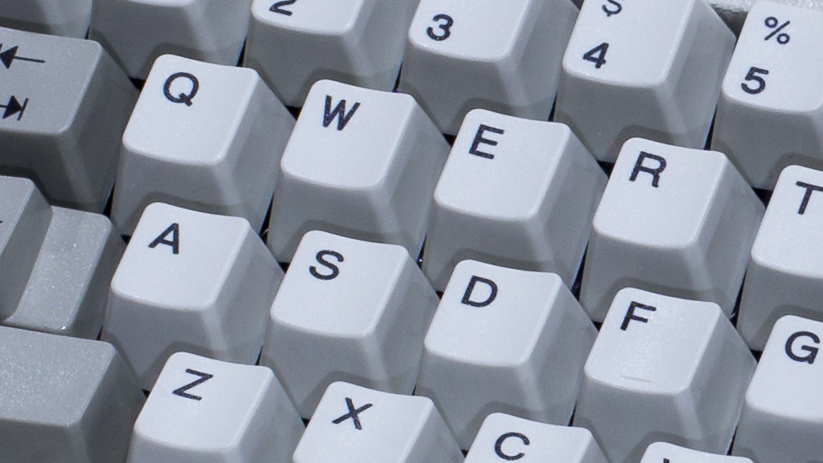
The keycaps above aren’t from the same keyboard, but they illustrate the difference that this guide can make nonetheless. Without further ado, let’s look at three keyboard cleaning tiers.
Preventive Cleaning
You should clean your keyboard lightly on a regular basis. Preventing grime accumulation is important, and it is even more critical if you eat next to your keyboard. Over time, dust and food will partially fuse to the painted metal plate that supports each keyswitch. That’s both nasty and inconvenient, as the particles must be brushed away once attached.
1. Unplug your keyboard.
2. Use a vacuum to remove dust from its plate. Gently pressing the vacuum’s attachment tube down on the keycaps, ultimately actuating each key on the keyboard, will give the best results. Small handheld vacuums without rotating brushes work well.

3. Wipe the entire keyboard down with a slightly damp microfiber cloth.
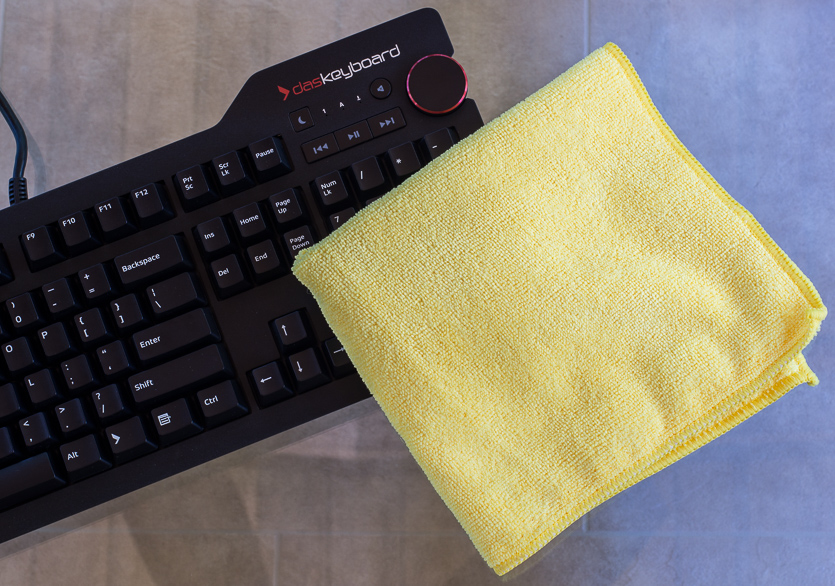
4. Dry it with another cloth. Do not use a paper towel, as paper towels will shed particles on the keyboard and create tiny scratches in its surface.
Avoid canned air at all costs when cleaning keyboards, as two negative side effects are possible. First, canned air is quite cold when it is released. That can cause condensation to build on scratches or worn metal surfaces, which could lead to corrosion or fused grime. Canned air can also blow dust directly into a keyboard’s switches, resulting in an unpleasant gritty feeling. Vacuum cleaners overcome those issues by pulling room temperature air, and therefore dust, away from the switches.
Deferred Cleaning
Some grime is stubborn, binding to the plate in spite of regular vacuum treatments and wipe downs. In addition, a layer of finger oils will gradually build up on your keyboard’s keycaps. Thankfully, there are tried and true methods that resolve those issues.
1. Unplug your keyboard.
2. Use a keycap puller to remove the keycaps from your keyboard. Most big keys are stabilized with wires (space, enter, shift, etc.), which makes them more difficult to remove. If you aren’t comfortable with removing and reseating them, it’s best to wipe them clean with a slightly damp microfiber cloth.
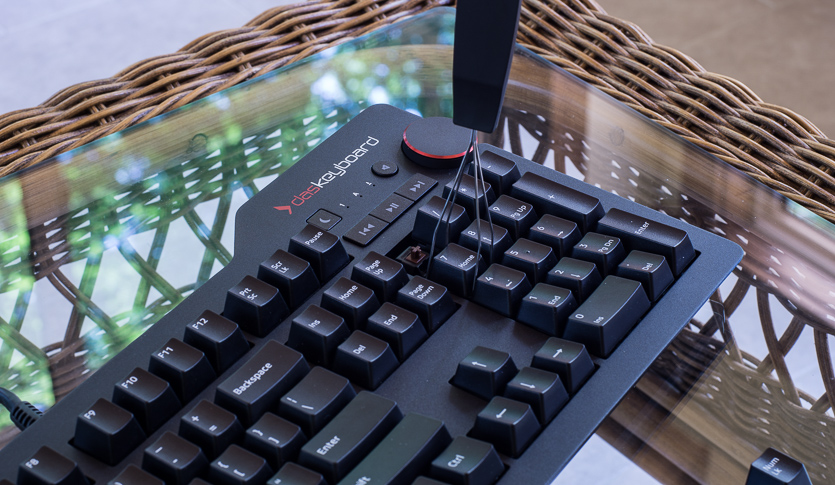
3. Clean the keycaps with denture tablets or dish soap.
Place the keycaps in a container, cover the keycaps with warm water, and place two tablets in the bath. Soak for at least 6 hours, rinse thoroughly, and lay the keycaps out stem up to air dry. It will take some time for the water to evaporate from the keycaps’ plus (+) shaped recesses. Dish soap is the second best choice, as it is difficult to rinse away.
Denture tablets are an ideal keycap cleaner. They remove oils, sterilize, and leave little to no residue.
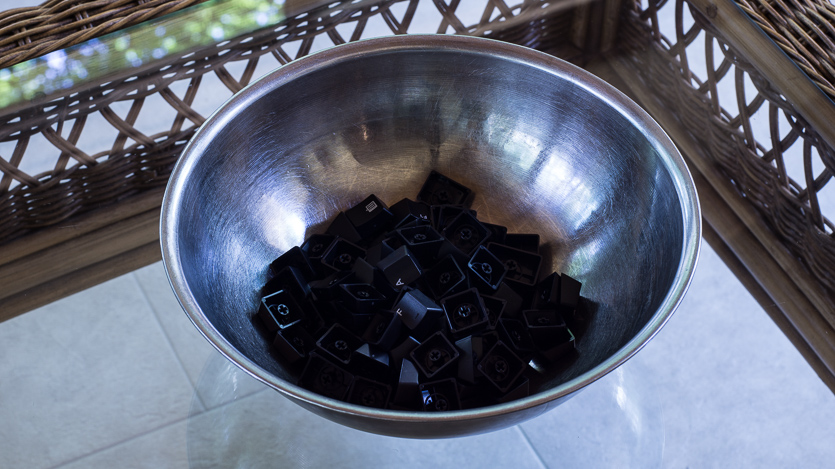
4. While the keycaps soak, use a small stiff-bristle brush (or a dry Q-tip, which might deposit a few bits of undesirable fuzz) to loosen particulate matter that has adhered to the plate. Avoid getting the brush bristles near switch stems. The bristles could push dust deep into a switch, preventing vacuum removal.

5. Vacuum the plate thoroughly with a handheld roller-less model or the attachment tube of a full size machine. If there is loose debris that the vacuum won’t pick up, turn the keyboard upside down and let it fall off.
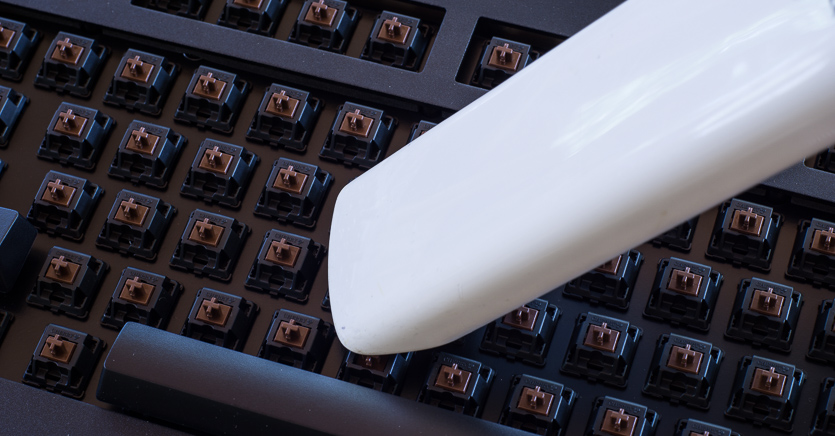
6. If there is a goo covered spot on the plate, use a slightly damp cloth or a Q-tip to wipe the mess up. Other small cleaning tools are viable as well. Avoid moistening the keyboard switches if possible.
7. Place the keyboard face down while the keycaps dry to prevent dust buildup.
8. Replace all keycaps.
9. Wipe the case down with a slightly damp microfiber cloth.
10. Dry it with another cloth, not paper towels. Paper towels leave particles and scratches behind.
Advanced Cleaning
Perhaps you chose to purchase a used keyboard. Let’s say that the previous owner used it in a dank basement and liberally sprinkled Cheetos between the keys. Maybe you’re that previous owner. We aren’t here to judge, especially if you’re looking to get things cleaned up. This guide is for keyboards that are filthy internally and externally. Following it will void your warranty, assuming that it is still active.
Follow steps 1 and 2 in the Deferred Cleaning guide, then continue with the following:
1. Consider using an ultrasonic cleaner to remove grime from the keycaps. They also work great for other household tasks like jewelry and toy cleaning. If you aren’t interested, just use the keycap soaking method described in step 3 of the Deferred Cleaning guide.
Add half your keycaps to the cleaner, cover them with water, plop two denture tablets in, and run the machine for 6 – 10 minutes. If your machine has additional instructions, like a minimum fill line, be sure to follow them. Stir at 2 minute intervals to ensure that each keycap is exposed to the ultrasonic transducers.
Ultrasonic cleaners work by vibrating water at high frequencies, which results in supercavitation that blasts grime away without harming substrates.
You can purchase ultrasonic cleaners from many stores, but eBay tends to have the best prices. Cleaners with at least 120 watts of ultrasonic power and a minimal volume (around 3 liters) perform well. Many have heating elements that can be used to warm up water. Some unscrupulous sellers advertise the combined heating and ultrasonic power as the total power. As always, purchase carefully. You should expect to spend $60 to $90 US for a passable household ultrasonic cleaner.
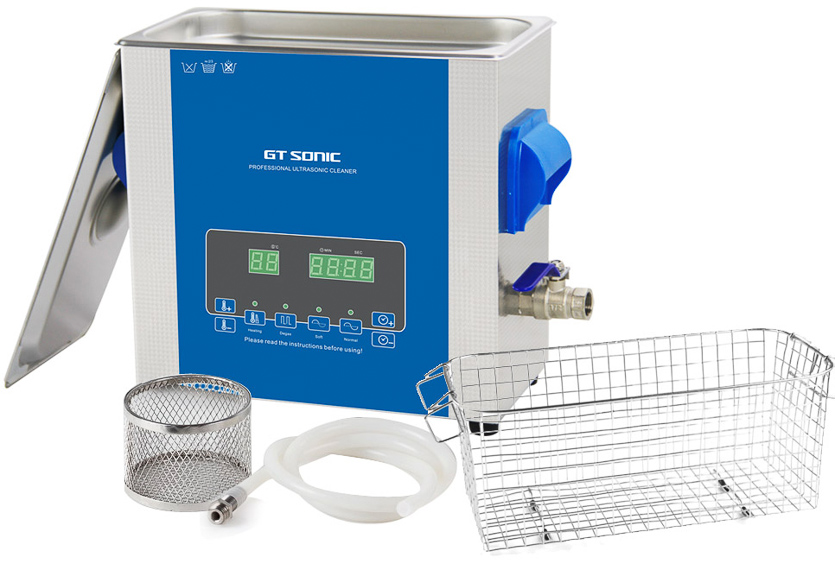
2. When the keycaps are finished, lay them out to dry with the plus shaped stem facing up. It may take some time for remaining water to evaporate completely.
3. Carefully open the keyboard case. Be sure to place its screws in a container. If they are different sizes, organizing them will help during the reassembly process. If there are cables that need to be detached, carefully do so. Take photos using your cell phone if you have trouble remembering what goes where.
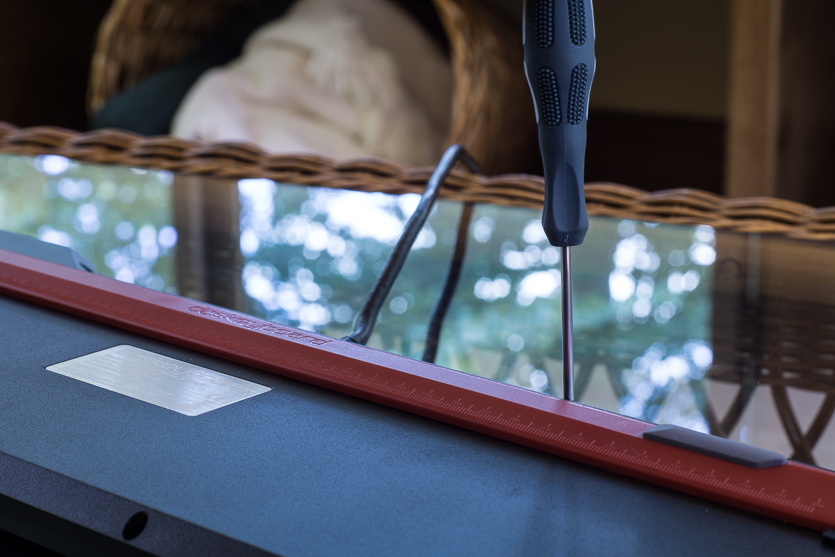
4. Once the keyboard is disassembled, set the PCB and plate aside. If the dirt and grime are somewhat mild, you can clean the case halves by vacuuming the inside with a brushed attachment. Follow that up with a damp cloth.
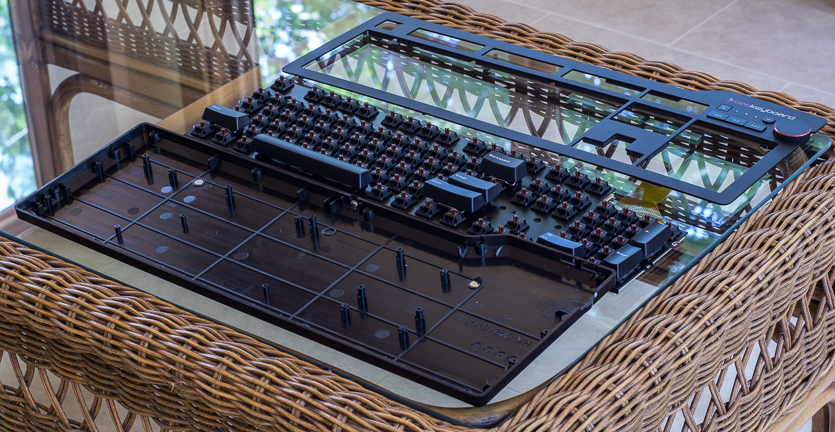
5. If the mess is severe (and there are no electronics attached to the case whatsoever) you can scrub the case halves with a medium-stiff bristle brush in a dish soap solution. Rinse thoroughly and dry both halves with a cloth, then allow water to evaporate from areas that cannot be accessed (like screw holes).
6. Use a small stiff-bristle brush to loosen particulate matter that has adhered to the plate. Avoid getting the brush bristles near switch stems. The bristles could push dust deep into a switch, preventing vacuum removal.
7. If there is a goo covered spot on the plate, use a slightly damp cloth or a Q-tip to wipe the mess up. Other small cleaning tools are viable as well. Avoid moistening the keyboard switches if possible.
8. Place the clean plate and PCB face down to prevent dust buildup while the other components dry.
9. When everything is dry, reseat all stabilized keys that are adjacent to the edge of the case. Space bar, keypad plus, and keypad enter are examples. You can lubricate the stabilizers if they rattle bothers you.
10. Assemble the keyboard.
11. Replace its keycaps.
Once you deep clean your keyboard, it should look professional and work like a charm.
Dealing With Spills
Spills are a mechanical keyboard’s worst enemy. Water isn’t particularly risky, assuming you unplug your keyboard quickly and let it dry for a good long while, but flavored drinks (particularly sugary ones) will mess things up in a serious way. Do not flip or tilt your keyboard when a spill occurs. In addition, do not test the keyboard on a computer that you care about once the spill has dried. It could damage the USB port or spam key presses and lock the system up.
1. If the liquid didn’t get into the switches or fry anything important, you can continue to use the keyboard after a Deferred Cleaning or Advanced Cleaning.
2. You can buy a new keyboard.
3. If you are familiar with soldering, it is possible to remove all of a keyboard’s switches. At that point, you could disassemble / clean each switch and keyboard component. You could also replace switches affected by the spill. The process is time consuming and labor intensive, so it isn’t recommended. It will also void your warranty, if applicable.
Wrapping Things Up
You’ve learned how to maintain mechanical keyboards. Have you considered picking one up? The Das Keyboard website offers high quality options for everyone from office workers to gamers. If you happen to have a mechanical keyboard, consider sampling another model with different switches. Amazing variety is part of the fun!
